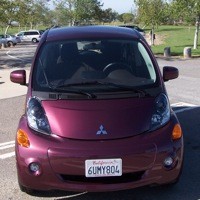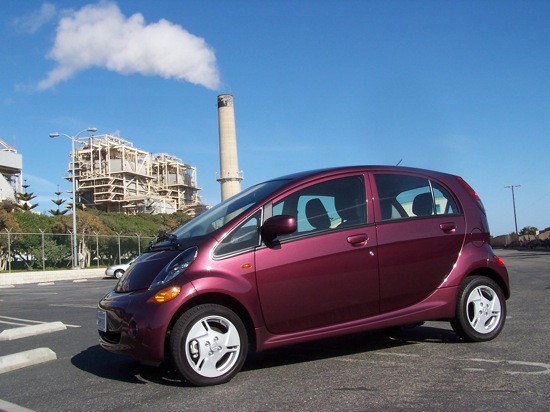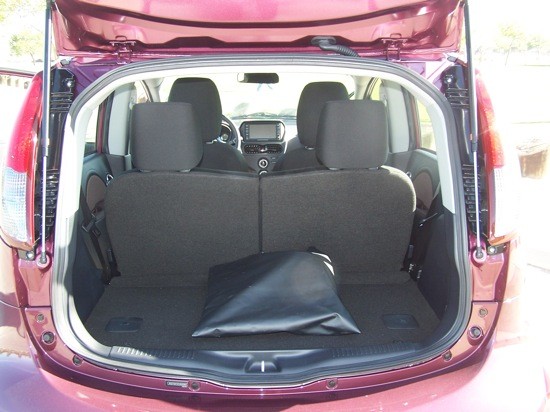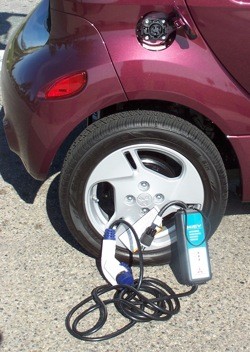
One in an occasional series reviewing consumer vehicles that are powered by water, natural gas, electricity, hybrid motors, high-efficiency gasoline engines or some other alternative source.
My first item in the “Ride Me” category was an obituary for Seal Beach's Doug Korthof, an environmentalist and electric-car advocate I'd written about and who was later featured in the documentary Who Killed the Electric Car?
I thought of Korthof while tooling around the beaches Seal and Huntington in a spiffy new Mitsubishi electric car.
]

Korthof let me test drive his
Saturn EV1 in 2003 from charging bays near Seal Beach Pier to another set at Huntington Beach's AEG electrical plant, which figures to be fired up this summer now that the San Onofre Nuclear Generating Station is offline. I drove a 2012 Mitsubishi i-MiEV SE from Costa Mesa to the electrical plant, but where I remembered the charging station being there is an animal hospital now. Oh, well.
I'd driven the electric car the evening before to the Seal Beach Pier area, which was drying out from flooding caused by rains and pounding surf the day before. It's still a trip to me turning the key on an electric and not hearing a gas engine fire up. Instead, a light on the instrument panel indicates “ready.” The Mitsubishi's silent running continues after plopping it into reverse gear and backing out of a driveway.
The MiEV zipped along nicely through city streets, powered
by high-capacity 16-KW lithium-ion batteries that are under the center floor and a 49-KW synchronous electric motor and
charging system toward the rear of the five-door hatchback. Braking
actually generates more power for the batteries, and your air conditioner runs on an electrical system that's independent of the juice that runs the engine.

Riding low to the ground, the sensation is like being in a tricked-out go-cart. It's actually a blast. Getting up to freeway speeds was not an issue, but the MiEV tops out at 80 mph, so speed racers do leave you in the dust. You can be smug in the knowledge that your annual fuel cost is $550, based on a national electricity
rate of $0.12 per kilowatt. You're also creating zero emissions, with EPA smog and fuel economy & greenhouse gas ratings of 10 each. And you get to pocket a $7,500 federal tax credit for the purchase of an EV.
Speaking of savings, Mitsubishi bills the MiEV as the most affordable electric car on the market, as low as $21,265 after the tax credit. The price of the SE I was driving was $34,765 because it was loaded with such extras as a navigation system with real-time traffic information, audio controls on the steering wheel, a rear-view camera, a battery warming system and heated side-view mirrors, among other luxuries.
Safety options include anti-lock brakes, stability and traction management and a tire pressure monitoring
system. Fog lights, floor mats, remote keyless entry, an eight-speaker deluxe audio system and power everything are standard on the SE.

You won't be dealing with filling stations–and
their per-gallon prices nearing the $5 mark–thanks to an easy-to-use
charger stowed in a bag in the roomy cargo space. Plug your car
into a standard 120v wall outlet overnight and you're good to go in the morning. A full charge is reached in seven hours. Mine was disabled, but the MiEV also comes with a quick-charge outlet
that will take a low battery to an 80-percent charge in about 30
minutes. Different driving conditions dictate how long you can drive on a full charge. The EPA says about 62 miles average for the MiEV, but I was informed if you're mostly driving city you can push that up to 100 miles.
When I was in Korthof's EV, he laughed as we passed gas stations, saying they would become obsolete once we all drove electric cars. I found this to be untrue while behind the wheel of the Mitsubishi MiEV, having to pull in one morning to wash my windshield before being on my way.
Ride: 2012 Mitsubishi i-MiEV SE 5-Door Hatchback
Likes: With no higher scores possible for smog and global warming scores, and an average EPA fuel economy rating of 112 MPGe,
based on 126 MPG/city and 99 MPG/highway, leaving a smaller carbon footprint while enjoying a helluva fun ride.
Knocks: I know that this is going to sound weird, but as two of us were driving along PCH at the speed limit one night, the car started getting jerky, as one would if it needed new shocks. We weren't driving over potholes and neither passenger was morbidly obese. Hmmm . . .
Previous Ride Me review:

OC Weekly Editor-in-Chief Matt Coker has been engaging, enraging and entertaining readers of newspapers, magazines and websites for decades. He spent the first 13 years of his career in journalism at daily newspapers before “graduating” to OC Weekly in 1995 as the alternative newsweekly’s first calendar editor.

